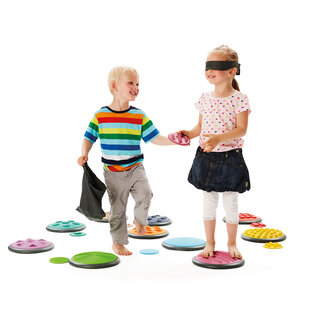Gonge tactile discs - sensory play materials
These coulourful tactile discs are shaped to appeal to a child's curiosity. Playing with tactile discs will stimulate children's and toddler's sense of touch - or tactile sense - as they can feel, recognise and differentiate between the different surface textures. The combination of large and small discs helps integrate the sensual impulses generated by hands and feet respectively. This can be further emphasised by encouraging the children to describe the texture and colours of the discs they are playing with.
Contents of the set
- 10 large sensory discs in different colours and with various textures (27 cm diameter)
- 10 small sensory discs in different colours and with various textures (11 cm diameter)
- Blindfold
- Cloth bag for storage
- Instructions by Gonge
Use of sensory tactile discs - tactile play materials
New tactile material that stimulates children's sense of touch on both hands and feet. This tactile material develops the ability to describe sense impressions verbally. The tactile discs contain different tactile structures. Each sensory disc has his own colour. Below you find some interesting ways how to use these great tactile materials:
- Children can see, feel and describe the colours and texture of the sensory discs as they play with them
- A good exercise is to ask them to describe the tactile impression of the surface - such as smooth, hard, small and knobbly, spiky or sharp
- The idea is that the large disc is laid on the floor and then the smaller tactile sensory discs are placed individually next to the corresponding large discs. Toddlers can match the sensory discs by feeling the texture and see the colour. Older children will find feeling the texture alone will be sufficient; the large sensory discs should be felt with their feet, whilst the small tactile discs can be felt either by placing them against the child's back or letting the child feel them while they are concealed in the bag or while the child is wearing the blindfold
- Older children can first be shown where the large disc is placed and each take a turn with the blindfold on. The objective is for them to find one of the smaller discs whilst blindfolded, and by using their sense of feel and memory to find the corresponding large tactile disc
- Two children can play together by one being blindfolded, whose task is to match the discs, whilst the other hands his/her partner the next small disc once one has been found and identified.
The game can be made more challenging by moving the discs around on the floor once the child has been blindfolded – sense of feel alone must then be used to find the correct discs
- Oral-tactile recognition and tactile play: a child or adult describes the texture of a small disc while it is concealed in the bag. One or more children then have to find the corresponding large disc. This game can be played as a competition in which the winner is the first to correctly identify the most discs
- The Gonge discs can also be used to develop balance by using them as stable stepping-stones in courses designed to stimulate motor function. If a child touches the ground around the discs when negotiating the course, he/she is 'out'
For further inspiration, watch the video below:



